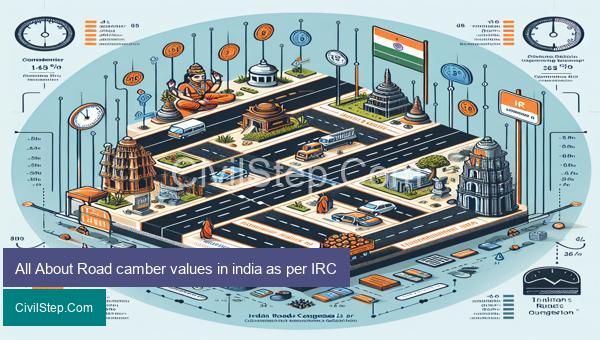
Road camber is an important factor that affects the stability and safety of a road, especially in a country like India where road infrastructure development is constantly evolving. The Indian Roads Congress (IRC) sets the standard for road design, construction and maintenance in the country. In this article, we will dive into the details of road camber values as per the IRC guidelines in India. Understanding these values is crucial for engineers, construction companies and policymakers to ensure the proper functioning and durability of our roads. So, let us explore the significance of road camber values in the Indian context and how they are determined by the IRC.
Road camber values in india as per IRC

Road camber, also known as road cross slope, refers to the slope or gradient of a road surface from the centerline to the edge. In India, the standards for road camber values are governed by the Indian Roads Congress (IRC), which is the apex body of highway engineers in the country.
The main purpose of having a camber on a road is to ensure proper drainage of rainwater from the road surface, which helps in avoiding waterlogging and maintaining the structural integrity of the road. In addition, a proper camber also aids in the safe and smooth movement of vehicles, especially during wet weather conditions.
According to IRC standards, the recommended camber value for different types of roads are as follows:
1. National Highways (NH) – The minimum camber value for NH roads is 1.5%. This means that for every meter of road width, there should be a cross slope of 15 mm. However, in urban areas, the recommended camber value can be reduced to 0.5%.
2. State Highways (SH) – The minimum camber value for SH roads is also 1.5%, except for hill roads where it can be reduced to 1%.
3. Major District Roads (MDR) – The camber value for MDR roads varies as per the terrain. For plain terrain, it should be 2%, for hilly terrain it should be 3%, and for steep terrain, it can be reduced to 1%.
4. Village Roads (VR) – The recommended camber value for VR roads is 3% for plain terrain and 1.5% for hilly terrain.
5. Expressways – As per IRC, the minimum camber value for expressways should be 2%.
It is important to note that the camber values may vary depending on the type of pavement surface and the materials used in the construction of the road. In some cases, a higher camber value may be required to compensate for the differences in the surface texture and friction.
Moreover, the IRC also recommends that the camber should be uniform along the entire length of the road and should not change abruptly. The transition between the centerline and the edge should be gradual to ensure a smooth driving experience for the vehicles.
In conclusion, road camber values in India as per IRC guidelines are based on various factors such as road type, terrain, and pavement surface. It is essential to adhere to these standards to ensure safe and efficient movement of vehicles and to maintain the longevity of the road infrastructure.
Conclusion
In conclusion, road camber values in India are an important aspect to consider for the construction and maintenance of roadways. The Indian Road Congress (IRC) has developed guidelines to ensure safe and efficient road camber designs. It is crucial for engineers, planners, and contractors to understand and adhere to these values to ensure the durability and longevity of roads in India. By keeping up with advancements and implementing proper road camber values, we can improve the overall driving experience and promote road safety for all. As the country continues to grow and develop, it is imperative that we prioritize the proper design and maintenance of road cambers to facilitate smooth and safe transportation for all citizens.
